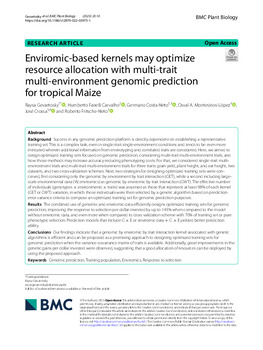Enviromic-based kernels may optimize resource allocation with multi-trait multi-environment genomic prediction for tropical maize
Abstract
Background: Success in any genomic prediction platform is directly dependent on establishing a representative training set. This is a complex task, even in single-trait single-environment conditions and tends to be even more intricated wherein additional information from envirotyping and correlated traits are considered. Here, we aimed to design optimized training sets focused on genomic prediction, considering multi-trait multi-environment trials, and how those methods may increase accuracy reducing phenotyping costs. For that, we considered single-trait multi-environment trials and multi-trait multi-environment trials for three traits: grain yield, plant height, and ear height, two datasets, and two cross-validation schemes. Next, two strategies for designing optimized training sets were conceived, first considering only the genomic by environment by trait interaction (GET), while a second including large-scale environmental data (W, enviromics) as genomic by enviromic by trait interaction (GWT). The effective number of individuals (genotypes × environments × traits) was assumed as those that represent at least 98% of each kernel (GET or GWT) variation, in which those individuals were then selected by a genetic algorithm based on prediction error variance criteria to compose an optimized training set for genomic prediction purposes. Results: The combined use of genomic and enviromic data efficiently designs optimized training sets for genomic prediction, improving the response to selection per dollar invested by up to 145% when compared to the model without enviromic data, and even more when compared to cross validation scheme with 70% of training set or pure phenotypic selection. Prediction models that include G × E or enviromic data + G × E yielded better prediction ability. Conclusions: Our findings indicate that a genomic by enviromic by trait interaction kernel associated with genetic algorithms is efficient and can be proposed as a promising approach to designing optimized training sets for genomic prediction when the variance-covariance matrix of traits is available. Additionally, great improvements in the genetic gains per dollar invested were observed, suggesting that a good allocation of resources can be deployed by using the proposed approach.

